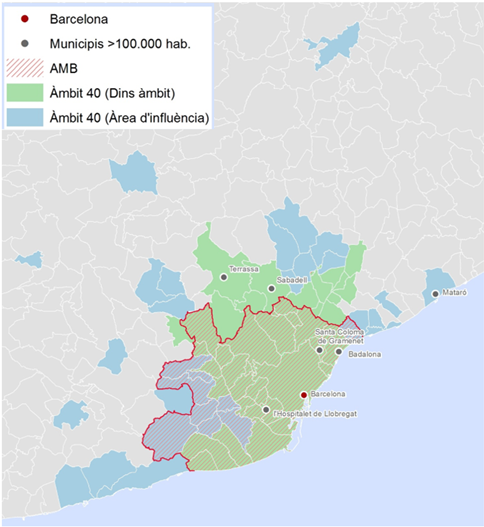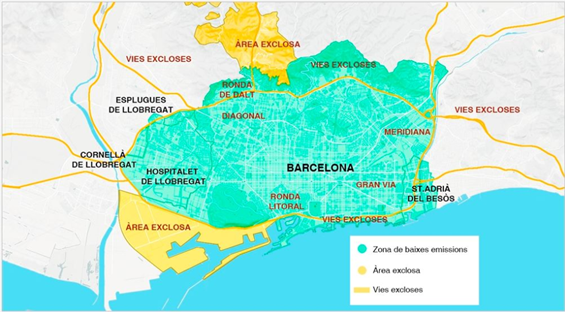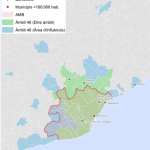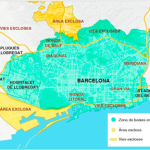From December 1st 2017, by virtue of an institutional agreement, the Department of Territory and Sustainability (DTES) of the Generalitat de Catalunya can declare episode situations of environmental air pollution in Barcelona. The agreement was signed in March 2017 between the main agents and the public administrations in Area 40 of the Barcelona conurbation (see figure 1).
During such episodes, the DTES is expected to trigger a series of measures aimed at reducing emissions of nitrogen dioxide and particles of less than 10 microns in diameter. The objective is to reduce traffic emissions in Area 40 by 10% in the next 5 years, and by 30% within 15 years in order to reach the levels recommended by the World Health Organization (WHO).

Area 40 (in green in Figure 1) includes 40 municipalities and is defined as a zone of special protection of the atmospheric environment, to tackle emissions of nitrogen dioxide (NO2) and particles in suspension of less than 10 microns diameter (PM10). The agreement also defines an Area of influence of Area 40 (in blue in Figure 1), which includes 34 additional municipalities.
An environmental episode of high air pollution is defined as a situation in which the meteorological conditions are unfavourable for dispersion and ventilation. This may increase the concentration of one of the two pollutants, and may lead to an excess of the limit values established by legislation.
In these cases, three scenarios can be given:
- Preventive notice to an episode statement, but without declaration of environmental episode
- Declaration of environmental episode due to high pollution without traffic restrictions
- Declaration of environmental episode due to high pollution with traffic restrictions (only activated by pollutant NO2)
In the case of an episode declaration with traffic restrictions, the circulation of all cars and vans that have not received a label issued by the General Directorate of Traffic identifying the level of emissions of the vehicle will be prohibited. The restriction applies to the Low Emissions Zone (ZBE). See figure 2.

The traffic restrictions will be applied in order to reduce emissions on days with a lower dispersion of atmospheric pollutants. The DTES calculates that the limitations in the ZBE of Barcelona (see figure 2) will reduce around 18% the urban emissions on both NO2 and suspended particles with a diameter of less than 10 microns (PM10). This figure represents 11% of the emissions associated with traffic in the entire Barcelona conurbation.
At the same time restrictions on private transport are put into place, special measures to improve the public transport network are also applied, such as:
- Increase in the public transport offer during the episode of high air pollution
- Guidance and information about the closest P & R station via the public transport route planner “Mou-te”. This measure will be permanent throughout the year.
- Creation by the ATM of a transport ticket, for use only during the episode, to attract new travellers (T-aire). The new title offers two trips on public transport at a price 10% lower than that of the 10-trip Card (T-10). More information.
- Creation of the T-verda card that entitles 3 years of free public transport for all integrated public transport services of the Barcelona ATM. Vehicle owners who give up and demolish a light diesel vehicle up to Euro 3 (manufactured before 2005), or gasoline or gas up to Euro 1 (manufactured before 1996) and motorcycles type pre-Euro or Euro 1, and do not acquire any new vehicle during the term of three years. More information.
To carry out these measures, the ATM together with the agents involved, have drafted a protocol detailing the actions to be taken by each one of them in each level of alert, the activation mechanisms of the measures to reinforce public transport, the infrastructures and the T-air title, as well as the communication channels and the coordination of the institutions.
The ATM has created a tool in web format to monitor the activation of public transport reinforcements agreed with public transport operators, which also allows the monitoring of historical data on the measures taken.
When will traffic restrictions occur?
The restrictions will be implemented in 2019, 2020 and 2025, according to the following calendar:
As of January 1, 2019: Vans prior to Euro 1 (registered before 1994) and Euro 1 and prior cars (registered before 1997) will not be able to circulate the weekdays throughout the ZBE
As of January 1, 2020: Permanent prohibition of circulation within the ZBE of vehicles without labels of the DGT. For working days from 7 in the morning to 8 in the afternoon.
As of January 1, 2025: Permanent prohibition of circulation in the municipalities that make up the Metropolitan Area of vehicles without labels of the DGT.
Other related measures
In the short and medium term, the political agreement signed in March also contemplates other measures related to mobility, some of them still under study:
- Promote the renewal of the vehicle fleet with aids and bonuses in the tolls, to replace them progressively with low emission vehicles.
- Facilitate the flexibility of the public staff of the Generalitat during the environmental episodes.
- Implementation of a possible access toll to the central conurbation.
- Study the introduction of a surcharge on the price of fuels.
- Drafting of a white paper on good logistical practices aimed at rationalizing the urban distribution of goods.
For information contact mr Lluis Alege.

